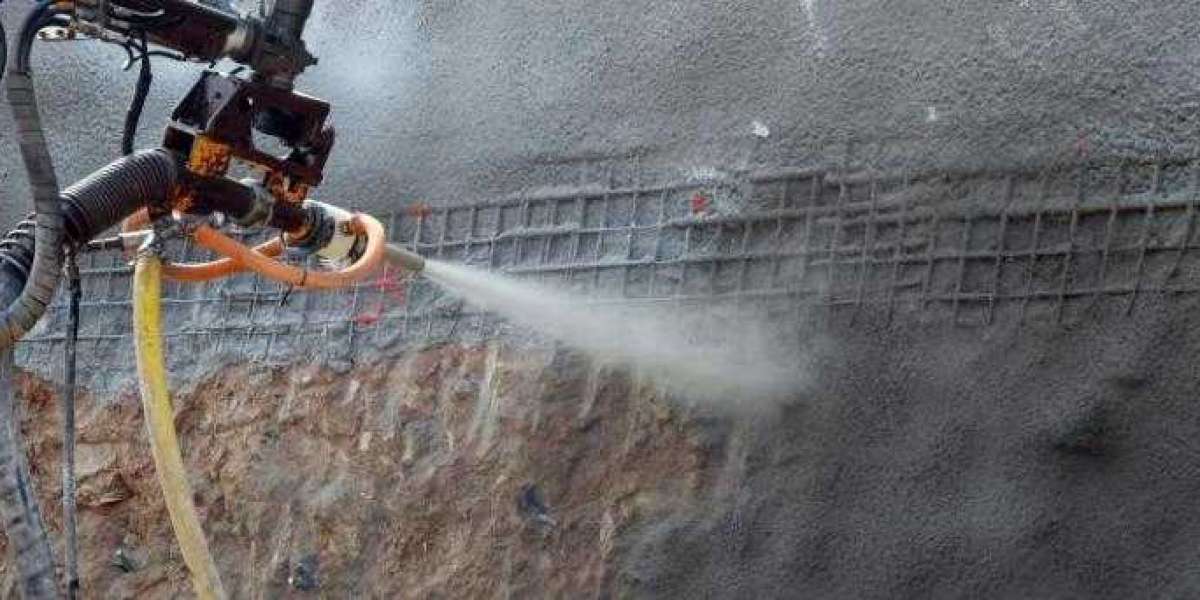The global shotcrete/sprayed concrete market is witnessing substantial growth, driven by the increasing demand for efficient construction techniques, infrastructure rehabilitation, and tunneling applications. Shotcrete—also known as sprayed concrete—refers to concrete or mortar conveyed through a hose and pneumatically projected at high velocity onto a surface. It offers several advantages over traditional concrete placement, including superior bonding, flexibility in complex geometries, and reduced labor requirements. These features have made it a preferred material in infrastructure development, mining, water-retaining structures, and slope stabilization projects worldwide.
As the construction industry focuses increasingly on sustainability and efficiency, shotcrete’s reduced rebound rates and optimized material usage align with global green building standards. This shift toward sustainable construction practices is expected to significantly influence the market trajectory in the coming decade.
Market Size and Growth
According to recent market estimates, the shotcrete/sprayed concrete market was valued at USD 9.1 billion in 2024 and is projected to reach USD 16.7 billion by 2035, expanding at a compound annual growth rate (CAGR) of 5.7% from 2025 to 2035. This growth is underpinned by rapid urbanization, infrastructure modernization initiatives, and a surge in tunneling and mining projects. Government investments in transportation networks—such as metros, highways, and bridges—are further fueling demand for sprayed concrete, given its superior performance in vertical and overhead applications.
Furthermore, innovations in admixtures and accelerator technologies are enhancing the strength and setting properties of shotcrete, leading to higher adoption across developed and emerging economies alike.
Market Segmentation
The shotcrete/sprayed concrete market is segmented by process, application, and end-use industry.
- By Process: The market is primarily divided into wet mix and dry mix shotcrete. The wet mix process dominates due to its consistent quality, reduced dust generation, and enhanced workability—making it ideal for large-scale infrastructure projects. However, the dry mix variant continues to find use in smaller repair works and remote construction sites where flexibility is critical.
- By Application: Key applications include tunneling, mining, repair works, water-retaining structures, protective coatings, and slope stabilization. The tunneling and mining segment accounts for a significant share, supported by rising underground construction projects in urban centers and expansion in the global mining industry.
- By End-Use Industry: The construction and infrastructure sector leads in market share, followed by mining and energy. Increasing rehabilitation and maintenance activities in aging infrastructure are expected to sustain long-term demand.
Regional Analysis
Regionally, Europe and Asia Pacific hold dominant positions in the shotcrete market. Europe leads due to advanced construction technologies, strict quality standards, and significant use in tunneling and restoration projects across Germany, Switzerland, and Scandinavia. Meanwhile, Asia Pacific is emerging as the fastest-growing region, driven by large-scale urban infrastructure programs in China, India, and Southeast Asia.
North America continues to display steady growth, propelled by ongoing investments in energy infrastructure, underground storage, and the refurbishment of transportation tunnels. In contrast, Latin America and the Middle East Africa are gaining traction due to expanding mining and oil gas activities that increasingly rely on shotcrete for structural support and lining applications.
Market Drivers and Challenges
Key drivers of the market include the growing emphasis on cost-efficient construction, the need for durable reinforcement materials, and advancements in shotcrete machinery and admixtures. The technology’s ability to provide rapid structural stabilization, especially in geologically unstable regions, makes it indispensable for mining and tunneling projects.
Market Trends
Several notable trends are shaping the future of the shotcrete industry. The adoption of robotic spraying systems and remote-controlled application techniques is improving safety, precision, and productivity on construction sites. In addition, the development of eco-friendly admixtures, low-carbon cement blends, and recycled aggregates aligns with the global shift toward sustainability in construction materials.
Moreover, digitization in construction—through Building Information Modeling (BIM) and 3D printing technologies—is enhancing project visualization and enabling customized shotcrete formulations to meet specific performance criteria. Collaborations between equipment manufacturers and chemical companies are leading to integrated solutions that combine high-performance materials with advanced delivery systems.
Competitive Landscape
The global shotcrete/sprayed concrete market is characterized by a mix of established multinational players and regional specialists. Leading companies include Shotcrete Technologies, Inc., Meta Therm Furnace Pvt. Ltd., REED, Master Builders Solutions, Chembond Construction Chemicals Limited, Heidelberg Cement, GCP Applied Technologies, The Euclid Chemical Company, The QUIKRETE Companies, CEMEX S.A.B. de C.V., and Rockbond.
These firms focus on expanding their product portfolios, investing in RD for high-performance admixtures, and forming strategic partnerships with construction contractors to strengthen market presence. Mergers and acquisitions are also reshaping the competitive dynamics, fostering technological innovation and operational efficiency across the value chain.
Future Outlook
Looking ahead to 2035, the shotcrete/sprayed concrete market is set for sustained expansion driven by urban infrastructure development, smart city initiatives, and innovations in green construction. As countries invest heavily in underground transport, water management systems, and energy facilities, shotcrete will continue to play a critical role due to its adaptability and superior performance characteristics.







